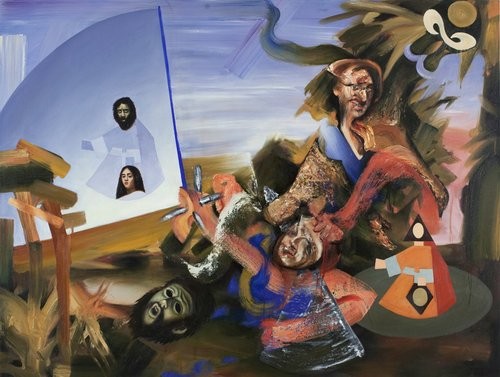Pieter Schoolwerth
01 Feb - 01 Mar 2009

© Pieter Schoolwerth
Judith Slaying Holofernes (after Cole), 2009
Oil on canvas
62 x 83 inches (157.5 x 210.8 cm) previous
Judith Slaying Holofernes (after Cole), 2009
Oil on canvas
62 x 83 inches (157.5 x 210.8 cm) previous
PIETER SCHOOLWERTH
"The Z-axis Cycle"
Dates: February 1 – March 1, 2009
Reception: Sunday, February 1, 6:30 – 9 PM
Opening on Sunday, February 1st, Miguel Abreu Gallery is pleased to present The Z-axis Cycle, Pieter
Schoolwerth’s second one-person exhibition at the gallery.
Working as a figurative painter today, one cannot but confront painting’s dauntingly rich history. Instead of embracing either the impulse to 'critique', or 'subvert' this tradition, or even to 'express oneself' through it, Pieter Schoolwerth chooses to literally use paintings of the past as the raw material upon which to ground his current practice. The works in this new cycle are built entirely with images culled from European figurative and landscape painting from the 16th to the 19th centuries.
The process Schoolwerth unfolds to produce each work in this series is identical. He begins by schematically reproducing a selected landscape painting onto the whole surface of the canvas. In the four works at hand, the artist engages paintings that depict deep recessional spaces by Pieter Bruegel the Elder (1525-1569), Abraham Bloemaert (1564-1651), Thomas Cole (1801-1848), and Francesco Hayez (1791-1882). In this initial step Schoolwerth ‘abstracts’ each landscape by plotting it with a large brush, leaving the viewer with an ambiguous impression of the originary picture's presence below the surface. The viewer is invited to consider these back-‘grounds’ as sets – as in a television or film set. He then inscribes into these scenes figures apprehended from other works from the classical tradition that are often completely unrelated to the background sources in terms of both period and style. In Allegory of Painting in a Landscape (after Bruegel the elder), for instance, Schoolwerth turns the golden-ochre cornfield of Bruegel's The Corn Harvest into a theatre stage upon which appear the intertwined figures of Dosso Dossi's Jupiter and Mars Painting Butterflies. The figures themselves are painted in a style more akin to that of British modernist painters such as Francis Bacon or Frank Auerbach. As in other works in the cycle, the subject of this painting is allegorical in nature. It stages the act of painting and figurative depiction itself. This montage of historical figures and ground interact to produce a dialogical image in the present.
In short, through the pictorial principles of superimposition, stop-action and repetition, Schoolwerth calls upon elements of disparate paintings from history and weaves them into singular narrative and material arrangements. If the late 19th and early 20th centuries gave birth to modern painting by reducing the picture plane to a flat two-dimensional surface – the realm of the X and Y axes – he is attempting here to activate the Z axis in space by invoking images of the pre-modern past, and re-articulating them into new paintings with painterly languages that belong to more recent times.
"The Z-axis Cycle"
Dates: February 1 – March 1, 2009
Reception: Sunday, February 1, 6:30 – 9 PM
Opening on Sunday, February 1st, Miguel Abreu Gallery is pleased to present The Z-axis Cycle, Pieter
Schoolwerth’s second one-person exhibition at the gallery.
Working as a figurative painter today, one cannot but confront painting’s dauntingly rich history. Instead of embracing either the impulse to 'critique', or 'subvert' this tradition, or even to 'express oneself' through it, Pieter Schoolwerth chooses to literally use paintings of the past as the raw material upon which to ground his current practice. The works in this new cycle are built entirely with images culled from European figurative and landscape painting from the 16th to the 19th centuries.
The process Schoolwerth unfolds to produce each work in this series is identical. He begins by schematically reproducing a selected landscape painting onto the whole surface of the canvas. In the four works at hand, the artist engages paintings that depict deep recessional spaces by Pieter Bruegel the Elder (1525-1569), Abraham Bloemaert (1564-1651), Thomas Cole (1801-1848), and Francesco Hayez (1791-1882). In this initial step Schoolwerth ‘abstracts’ each landscape by plotting it with a large brush, leaving the viewer with an ambiguous impression of the originary picture's presence below the surface. The viewer is invited to consider these back-‘grounds’ as sets – as in a television or film set. He then inscribes into these scenes figures apprehended from other works from the classical tradition that are often completely unrelated to the background sources in terms of both period and style. In Allegory of Painting in a Landscape (after Bruegel the elder), for instance, Schoolwerth turns the golden-ochre cornfield of Bruegel's The Corn Harvest into a theatre stage upon which appear the intertwined figures of Dosso Dossi's Jupiter and Mars Painting Butterflies. The figures themselves are painted in a style more akin to that of British modernist painters such as Francis Bacon or Frank Auerbach. As in other works in the cycle, the subject of this painting is allegorical in nature. It stages the act of painting and figurative depiction itself. This montage of historical figures and ground interact to produce a dialogical image in the present.
In short, through the pictorial principles of superimposition, stop-action and repetition, Schoolwerth calls upon elements of disparate paintings from history and weaves them into singular narrative and material arrangements. If the late 19th and early 20th centuries gave birth to modern painting by reducing the picture plane to a flat two-dimensional surface – the realm of the X and Y axes – he is attempting here to activate the Z axis in space by invoking images of the pre-modern past, and re-articulating them into new paintings with painterly languages that belong to more recent times.
